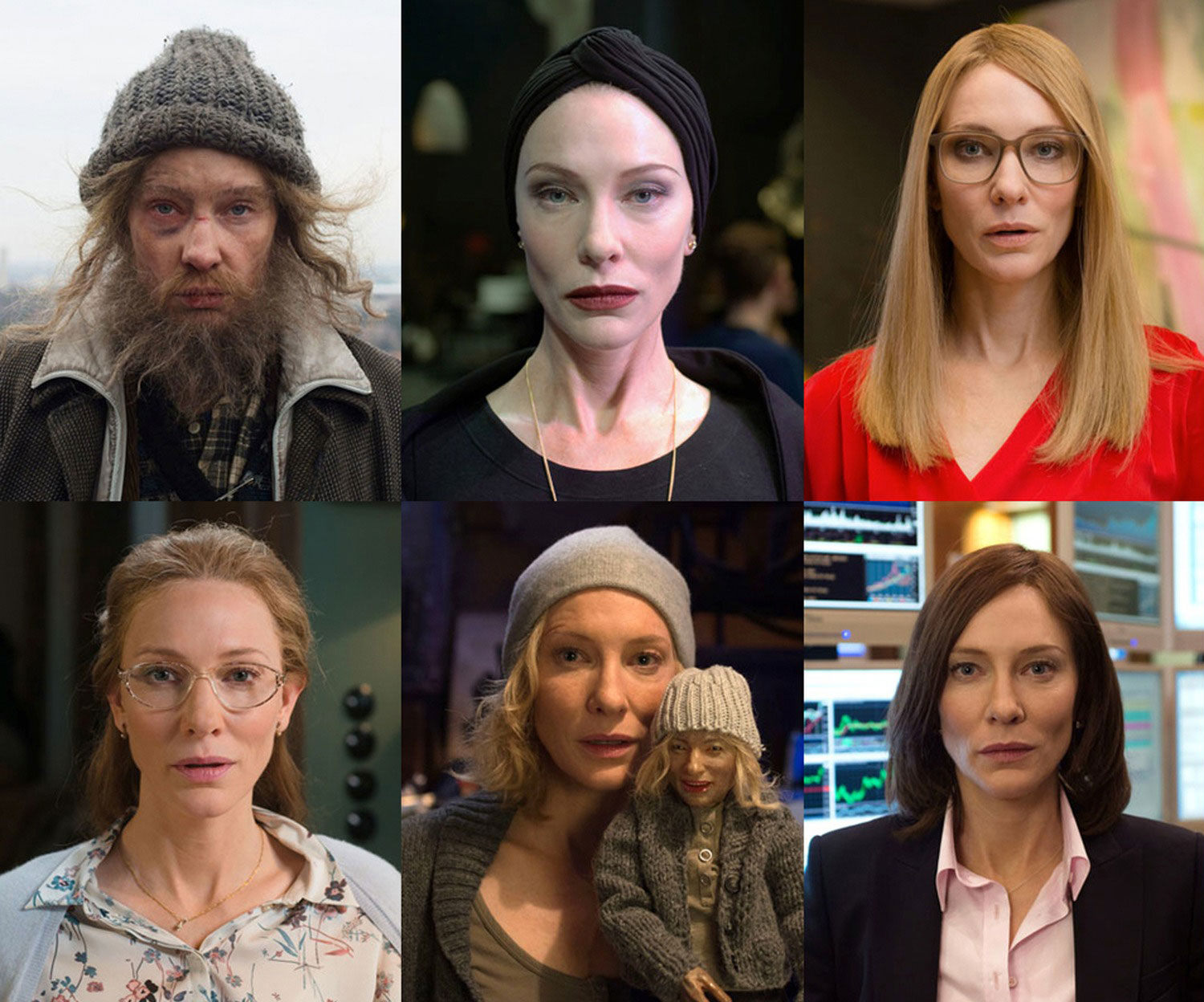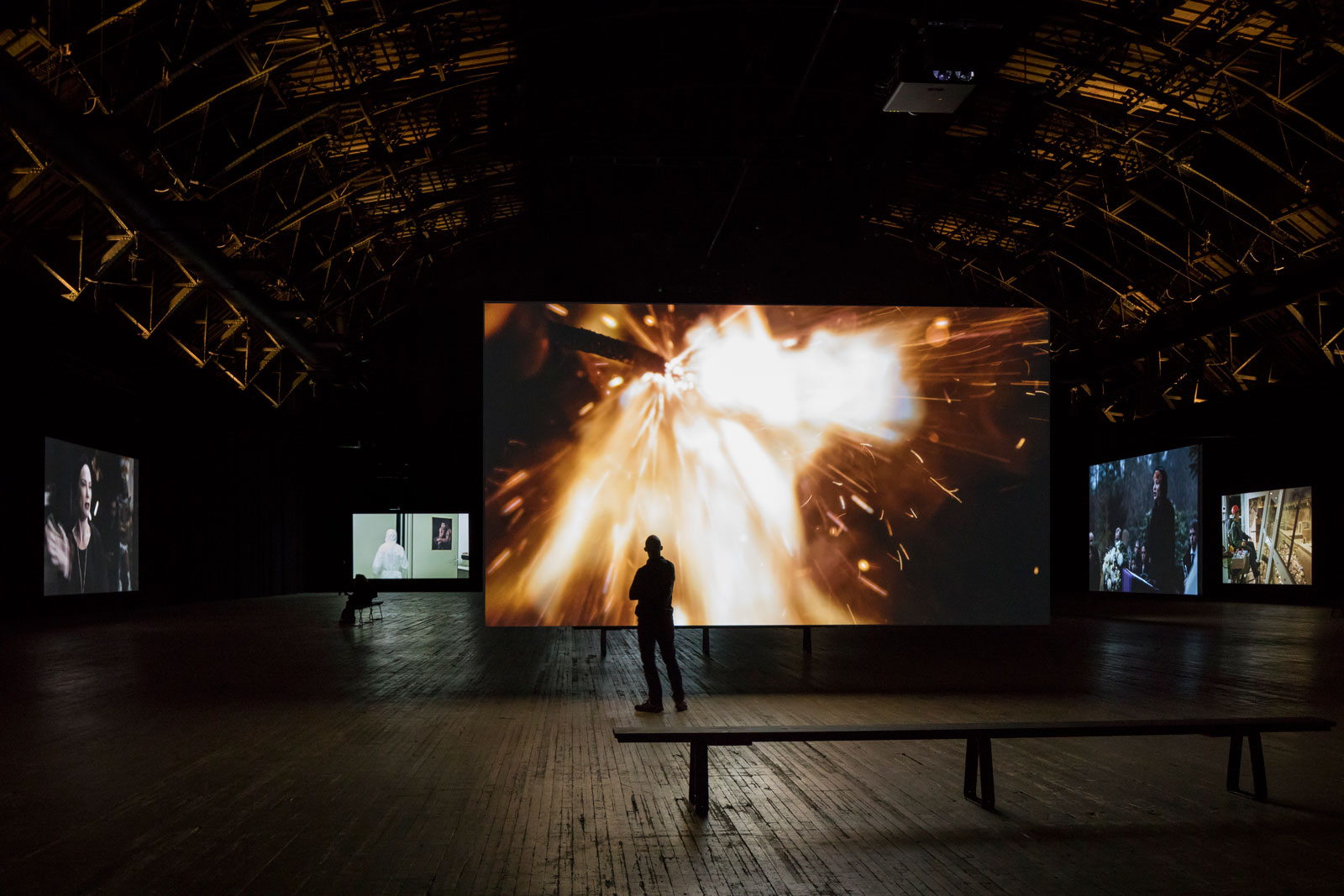An apparently conservative woman, wearing a cardigan draped over a floral blouse, carefully sets a table, and then calls her children and husband to lunch in a gentle Southern accent. The scene looks familiar—the mother holding down the fort and the children bored by all the waiting and ritual—but this is not an ordinary family meal. In the neighboring living room, a live raven squawks in the company of a taxidermy bear and deer, and when the family comes to the table, the woman (played by Cate Blanchett) launches into an unconventional grace. “I am for an art,” she begins solemnly, “that does something other than sit on its ass in a museum.” She goes on, scolding her sons for giggling when she declares that she is for art that is “abandoned with great contempt, like a piece of shit,” and that she is “for the art of pinching cockroaches.” The prayer ends with the final line of Claes Oldenburg’s 1961 manifesto “I Am for an Art,” from which the whole grace has been adapted. The mother, father, and two sons lower their heads and, instead of amen, utter the words: “square that becomes blobby.”
This is one of thirteen videos on loop in Julian Rosefeldt’s installation Manifesto, at the Park Avenue Armory through January 8. Twelve of the thirteen feature a different character, each one played by the virtuosic, versatile Blanchett, reciting what Rosefeldt calls “text collages,” which are woven together from different artists’ manifestos under the heading of an artistic movement—Conceptual Art/Minimalism, for instance, is presented through texts by Sol LeWitt, Elaine Sturtevant, and Adrian Piper, which are read by a newsreader and reporter. (The thirteenth video, listed as the “prologue,” stars a fire.) In several of the groupings, priority is given to sonic and thematic parallels rather than actual historical relationships. The Situationism text collage pulls not only from manifestos by the French Marxist Guy Debord and the Dutch painter Constant Nieuwenhuys, who were recognized members of the postwar Situationist International organization, but also from the 1932 anti-capitalist “Draft Manifesto” by the John Reed Club of New York, as well as texts from the Twenties by the Constructivist Alexander Rodchenko, and the late Forties by the Spatialist Lucio Fontana. The seams between the texts, though, are hard to detect, and the seamlessness suggests something not only about the ways in which ideas and themes reverberate and cycle throughout history, but also about the artifice of historical periodization.
With each character Blanchett plays, the chosen manifesto is given a different function and purpose. From the mother at mealtime it’s a creed; spoken by a homeless man or a drunken punk rocker, it’s an angry rant; a funeral speaker makes it an elegy; the newsreader transforms it into a report of current events; from a CEO giving a speech at a private party, it sounds like a pretentious and self-congratulatory toast; and when parts of a structuralist manifesto are projected over the loudspeakers of a large laboratory building, it becomes something like propaganda. But at each of the tasks Rosefeldt (and Blanchett) puts the manifesto to, it humorously fails. In the Fluxus/Merz/Performance film, Blanchett, playing a Russian choreographer, gives stage directions to a chorus of dancers. As if she were telling them to slow down or spread out, she instructs them to “flush the toilet, stay young,” to “strangle crate boxes,” to “take wheels and axels, throw them up and let them sing,” and to “make railway mist.” The dancers placidly take in their impossible instructions, which are lifted from the “Manifesto for Maintenance Art” by Mierle Laderman Ukeles and “The Merz Stage” by Kurt Schwitters. Just as the choreographer’s orders are impossible to heed, the funeral speaker’s words provide no consolation, instead telling the attendants that they are “all idiots” and that “it’s us who are the murderers of your newborn babies.” The grace lacks solemnity, and the newsreader’s report has nothing to do with anything actually happening. “Man’s new cyber form is God,” Blanchett declares, in full makeup and hair, perfectly capturing the scripted intonations of the anchor.
In other films, the text collage is narrated as if it were an internal monologue. In one, Blanchett is crafting a puppet version of herself while we hear her voice reading parts of Surrealist texts. Praise for the “beloved imagination” becomes an overt nod to the artistic practice on view, and the notion of “sleeping logicians” point to the slumbering human-like puppets themselves. The Futurist film, starring a financial broker, likewise tempts us with overly facile interpretations: the “beauty of speed,” the “network of speedy communication,” and the “frenetic life of our great cities” that the broker exalts, channeling the Futurists, could just as easily describe Wall Street. But the ease and poetry of these films, if less amusing or engaging than some of the others, provide a welcome respite to installation’s persistently clever tone.
Advertisement
At the end of each twelve-and-a-half-minute film, the featured character turns to face us and chant a portion of the manifesto in a robotic monotone, providing a kind of continuity with the installation as a whole. The screens are spread out around the enormous drill hall, which is completely dark but for the light from the screens, and the audio comes from a speaker hanging directly above the benches that sit before each screen. When I saw Manifesto at the Hamburger Bahnhof in Berlin in October, the space was much smaller, and from most spots several films were visible at once, competing for the viewer’s attention. The Armory’s spaciousness removes this element of distraction, allowing each film to stand more on its own.
This elaborately produced work is the most recent in a series of large-scale video installations created by Rosefeldt, who is based in Berlin. Two of his other recent works, My home is a dark and cloud-hung land (2011) and American Night (2009), feature sweeping shots of the German forest and the old American West, respectively, as well as more intricate scenes that play out national traditions associated with those locations—Germanic operas, fairy tales, romanticism, philosophy, and Nazi nature cults; cowboys, militaristic expansion, and saloons. In each work, Rosefeldt inserts original historical texts into the mouths of human characters, puppets, and mythical creatures. When cowboys in American Night chat around a fire, their language is drawn from classic Western films, speeches by George Bush and Charlton Heston, and rap songs by 50 Cent, to name just a few sources, resulting in an amusingly disjointed and anachronistic conversation.
Rosefeldt’s interest in the sort of text collages that show up in American Night and Manifesto goes back to his earliest films, which were entirely constructed from found footage. His 1998 film News features a compilation of the sharp breaths taken by dozens of television newsreaders before they begin speaking. Global Soap, from a few years later, compiles a series of nearly identical scenes and snapshots from soap operas around the world: characters barging into rooms, pointing their fingers accusingly, placing their hands on their chests as if to say, “Who, me?,” gesturing with index finger and thumb touching, dramatically fainting. One of the more remarkable segments features a rotation of twenty-eight snapshots, all from different soaps, in which one character is addressing another who is standing several paces ahead, to the right, with his or her back turned. Rosefeldt’s News and Global Soap draw attention to the artifices and rituals that govern the creation of news and popular media by stripping them of their narrative and newsworthy content.
Manifesto—which also includes sweeping, quiet landscape views in the style of American Night and My home is a dark and cloud-hung land interspersed with Blanchett’s verbal vignettes—likewise strips artists’ manifestos of the historical or artistic setting in which they were created and reassembles them in ways that draw out their recurring patterns: the words “no to…,” “not,” and “nothing,” the use of the present tense, references to garbage, death, and ghosts, for instance. At various moments in Manifesto, the newsreader criticizes our “obsession with high speed” and declares that “today is yesterday”; the scientist speaks of a “vacant future”; the broker speaks of a “futile veneration for the past” and praises the “beauty of speed”; the funeral speaker refers to the “frenzied cataract of life”; the garbage worker says that “in the distance shines our tomorrow”; the CEO calls the “present” the “only active thing”; the punk says “no more retrospection” and “no more futurism.” Each of these statements expresses a different relationship toward time but here they sound more alike than different. The declarations, in Rosefeldt’s care, become something like the sharp breaths of the anchors in his earlier film News—part of the grammar of manifestos more than discrete arguments.
When asked about the title of his new work, Rosefeldt told an interviewer that he
used the title Manifesto as a clear statement that the focus in this work is above all on texts, whether by visual artists, filmmakers, writers, performers or architects—and on the poetry of these texts.… Manifesto is an homage to the beauty of artists’ manifestos—a manifesto of manifestos.
And yet, on the whole, Manifesto suggests a rather less reverential attitude toward its chosen texts. Having each of the manifestos spoken by a female character (with the potential exception of the homeless person, who is described in the catalog as a man) serves to remind us that almost all of the manifestos cited in the exhibition catalog were written by men (forty-three out of the fifty); they are, as Rosefeldt observes, “just bursting with testosterone.” “Art historians,” he says,
Advertisement
tend to regard everything created and written by artists with reverence and respect, as if, from day one, the artists themselves intended their work to become part of art history. But we shouldn’t forget that these texts were usually written by very young men who had barely left their parents’ house when they reached for the pen.
Indeed, the newsreader’s declaration that “all current art is fake,” the punk rocker’s “to the electric chair with Chopin,” the broker’s “shit to Florence,” the teacher’s “nothing is original,” and the funeral speaker’s “you are all idiots” sound like the utterances of a high-school student giving his teacher a hard time. Removed from the cultural moment in which they were created, brought to life from the portentous pages of art history textbooks, and placed into the mouths of women trying to get things done, these text fragments become more like the cries of an adolescent visionary, perpetually misunderstood in a way that feels, while endearingly romantic, also presumptuous and privileged.
Manifesto is at the Park Avenue Armory through January 8.




